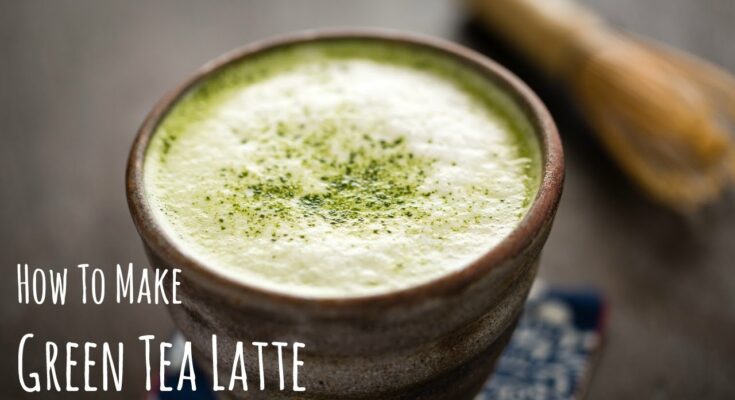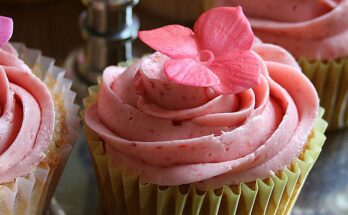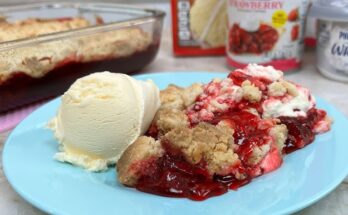Starbucks Matcha Latte Recipe: Have you noticed how matcha is everywhere these days? From local cafés to fancy Instagram reels, this vibrant green drink is no longer just a Japanese tradition—it’s gone global. Matcha, made from finely ground green tea leaves, has been used in Japanese tea ceremonies for centuries. But recently, it’s been popping up in everything from smoothies to baked goods. And yes, lattes too!
What makes matcha so appealing? It’s not just the gorgeous color—it’s packed with antioxidants, delivers a calm caffeine boost, and has a unique earthy flavor. Plus, it’s versatile. Whether you like it hot, iced, sweetened, or blended with plant-based milk, there’s a version out there for you.
When Starbucks introduced their Matcha Latte, it quickly became a favorite among health-conscious coffee shop regulars. It has just the right mix of creaminess and sweetness to satisfy your craving without being overpowering. And now, you can make it from the comfort of your own kitchen.
What Makes Starbucks’ Version Special?
Let’s be honest—Starbucks knows how to make a drink that hits all the right notes. Their Matcha Latte is smooth, sweet, and perfectly balanced. What sets it apart is the way they blend their matcha with sugar and milk. The result is a drink that’s incredibly easy to sip, even for those who aren’t hardcore matcha fans.
Starbucks uses a pre-sweetened matcha powder blend, which helps standardize the flavor across all locations. That’s good for consistency but not necessarily great if you’re trying to cut back on sugar. The good news? Making it at home gives you full control. You can tweak the sweetness, choose your milk, and even experiment with fun add-ins like vanilla or coconut.
Ingredients You’ll Need
Key Ingredients for Starbucks-Style Matcha Latte
Before we get to the fun part—making the latte—you’ll need a few simple ingredients. Here’s your grocery list:
- High-quality matcha powder (preferably ceremonial or culinary grade)
- Milk of your choice (dairy or non-dairy like oat, almond, or soy)
- Sweetener (white sugar, honey, agave, or maple syrup)
- Hot water (not boiling, just under 175°F / 80°C)
That’s it. Simple, right? But don’t underestimate how each of these ingredients affects your final drink. For example, different milks will give you different textures and flavors. Oat milk creates a creamy, neutral base, while almond milk gives it a nutty undertone.
Want that signature Starbucks sweetness? Try using vanilla syrup or a sugar-milk blend to replicate the pre-sweetened matcha they use in stores.
Choosing the Best Matcha Powder
Not all matcha is created equal. The quality of your matcha powder will make or break your latte. Here’s what to look for:
- Color: Bright, vibrant green is a good sign. Dull green or brownish matcha means lower quality.
- Origin: Look for matcha sourced from Japan—Uji and Nishio are renowned regions.
- Grade: Ceremonial grade is ideal for drinking and lattes; culinary grade is more budget-friendly and still works well for lattes.
Avoid matcha that tastes overly bitter or grassy. Good matcha should have a smooth, slightly sweet, umami flavor.
Dairy vs. Non-Dairy Options
Starbucks gives you the option to choose your milk, and you should too. Here’s a quick breakdown:
| Milk Type | Flavor Profile | Froth Level | Best For |
|---|---|---|---|
| Whole Milk | Creamy, rich | High | Traditional lattes |
| Oat Milk | Sweet, neutral | High | Vegan, creamy texture |
| Almond Milk | Nutty, light | Medium | Low-calorie option |
| Soy Milk | Slightly sweet, rich | Medium | Balanced plant-based |
| Coconut Milk | Sweet, tropical | Low | Coconut matcha blends |
Each milk type changes the mouthfeel and overall taste of the latte. Oat milk is a popular go-to for recreating that Starbucks-like creaminess without dairy.
Tools You’ll Need
Essential Kitchen Tools
Making a Starbucks-style Matcha Latte doesn’t require fancy equipment, but having the right tools helps a lot. Here’s what you’ll need:
- Matcha whisk (chasen) or handheld milk frother
- Small bowl or cup for whisking matcha
- Measuring spoons or kitchen scale
- Small saucepan (if heating milk manually)
- Glass or mug for serving
If you don’t have a matcha whisk, a small kitchen whisk or even a fork can work in a pinch. But the smoother the matcha, the better the taste and texture.
Optional Tools for a Creamier Finish
Want to elevate your latte? Consider these bonus tools:
- Electric frother: For barista-style foam.
- Blender: Great for making larger batches or iced versions.
- Thermometer: Helps avoid overheating your milk or water.
These aren’t must-haves, but they can take your homemade matcha latte from good to amazing.
How to Make Starbucks Matcha Latte at Home
Step 1: Gather and Measure Your Ingredients
Start by measuring out everything you’ll need:
- 1 to 2 teaspoons of matcha powder (depending on how strong you like it)
- ¼ cup hot water (just under boiling)
- ¾ to 1 cup milk (your choice)
- 1 to 2 teaspoons of sweetener
Pro tip: Use a fine mesh sieve to sift your matcha powder before mixing. It helps prevent clumps and gives you a smoother drink.
Step 2: Blend the Matcha Powder
Add your sifted matcha to a small bowl. Pour in the hot water and whisk it in a zigzag motion (an “M” or “W” shape) until it’s completely dissolved and slightly frothy.
If you’re using a milk frother, you can blend the matcha directly in your mug. No whisk? A tightly sealed jar works too—just shake vigorously.
Step 3: Heat and Froth the Milk
This step is where the magic starts to happen. Once your matcha is blended and smooth, it’s time to prep your milk. If you want a latte that rivals Starbucks, getting the milk texture just right is crucial.
Start by heating your milk on the stove or in the microwave until it’s warm but not boiling—around 150°F to 160°F (65°C to 70°C). Boiling milk can scorch and ruin the flavor, especially if you’re using plant-based alternatives.
Now, froth your milk. If you have a handheld milk frother, use it to create a nice, foamy texture. No frother? No problem. You can:
- Use a French press: Pump the plunger up and down vigorously.
- Shake it in a mason jar (lid tightly sealed!).
- Blend it in a high-speed blender for 20 seconds.
Frothing adds air to your milk and creates that luxurious mouthfeel you expect in a café-quality latte. This is especially important if you’re using almond or soy milk, which can sometimes fall flat without it.
Step 4: Mix and Combine
Here comes the best part—putting it all together. Slowly pour your frothy milk over the whisked matcha mixture. Use a spoon to hold back the foam so you can mix the liquid part first. Stir gently to combine.
Once the matcha and milk are fully mixed, top with the remaining milk foam. This step gives your latte that iconic layered look—green at the base with a fluffy, white top.
If you’re using vanilla syrup or honey, now is the time to drizzle it in. You can also sprinkle a pinch of extra matcha on top for that classic Starbucks-style finish.
Serve in a clear glass mug if you want to admire the vibrant color. Trust me, it’s worth the extra dish!
Step 5: Add Sweeteners and Finish
Starbucks lattes are known for their sweetness, and the same applies to their matcha version. Their pre-mixed matcha powder contains sugar by default. Since we’re using pure matcha, you’ll need to sweeten it yourself.
You have a few options:
- Classic white sugar (1–2 teaspoons)
- Honey or maple syrup (1 tablespoon)
- Vanilla simple syrup (Starbucks uses this for extra flavor)
- Stevia or monk fruit for a sugar-free option
Start small—you can always add more. Stir well until everything dissolves completely. Don’t skip this step: well-blended sweetness is key to that signature Starbucks flavor.
Now, taste it. Adjust the sweetness, froth, or even the matcha level based on your preference. That’s the beauty of making it at home—you’re the barista.
Iced Starbucks Matcha Latte Version
Iced vs. Hot: What’s the Difference?
If you’re more of a cold drink fan, you’re not alone. The iced matcha latte from Starbucks is just as popular—especially in summer. But there are a few key differences:
- Water temperature: You don’t need hot water for iced matcha—room temp or cold works fine.
- Frothing: No need to froth milk for iced; just shake or stir.
- Sweeteners: Liquids like simple syrup dissolve better in cold drinks.
The flavor profile is also slightly different. Iced matcha feels lighter and more refreshing, while hot matcha is creamy and comforting. Both are delicious—it’s just a matter of your mood (or the weather).
How to Make an Iced Matcha Latte
Making the iced version is just as simple:
Ingredients:
- 1–2 teaspoons matcha powder
- ¼ cup water (room temperature or slightly warm)
- 1 cup cold milk (any type)
- Ice cubes
- Sweetener to taste
Instructions:
- Sift your matcha powder into a jar or shaker bottle.
- Add the water and whisk or shake until fully dissolved—no clumps!
- Add your sweetener and stir again.
- Fill a glass with ice and pour in your milk.
- Top with the matcha mixture.
- Stir lightly or leave it layered for an Instagram-worthy look.
Optional: Add vanilla syrup, coconut cream, or even boba for a fun twist!
That’s it! You’ve just made an iced matcha latte that tastes exactly like—or dare I say, better than—Starbucks.
Tips for the Perfect Matcha Latte
Avoiding Clumps in Matcha
One of the most common issues people face with homemade matcha lattes is clumping. Nothing ruins a drink faster than gritty green lumps floating on top.
Here’s how to avoid it:
- Always sift your matcha powder before adding water.
- Use warm, not boiling, water—hot enough to dissolve the powder but not so hot that it scorches.
- Whisk in a zigzag motion using a bamboo whisk (chasen) or handheld frother.
- If all else fails, mix your matcha with a tiny bit of milk or sweetener first to form a paste, then dilute with water.
These small steps make a big difference. Your latte will be smoother, tastier, and much more enjoyable.
Achieving the Right Frothiness
That creamy froth on top isn’t just for looks—it adds texture and richness to your latte. Here’s how to get it just right:
- Use whole milk or oat milk for the creamiest froth.
- Heat milk slowly and avoid boiling.
- Use a milk frother or French press to aerate the milk.
Want extra foam? Let your frothed milk sit for 30 seconds before pouring—it gives the bubbles time to stabilize.
Bonus tip: Add a tiny pinch of salt to non-dairy milk while frothing. It enhances flavor and frothability!
Adjusting the Sweetness Level
Not a fan of overly sweet drinks? Good news: You’re in control.
- Start with half a teaspoon of sweetener.
- Taste as you go—remember, matcha has a bold flavor that can handle a bit of sugar.
- If using syrups, read labels for sugar content.
The goal is to balance the earthy taste of matcha with a touch of sweetness—not drown it. Starbucks uses a lot of sugar, but you don’t have to.
Nutritional Information
Calories and Macros
One of the reasons people turn to matcha lattes is for a “healthier” caffeine fix—but how healthy is it really?
A Starbucks Grande Matcha Latte (16 oz) made with 2% milk contains:
- Calories: 240
- Fat: 7g
- Carbohydrates: 32g
- Sugars: 32g
- Protein: 12g
- Caffeine: ~80mg
That’s a pretty hefty dose of sugar, especially for those watching their intake. But when you make it at home, you can drastically cut down the sugar content. Here’s a comparison:
Homemade Matcha Latte (with oat milk and 1 tsp honey):
- Calories: ~120
- Fat: 3.5g
- Carbohydrates: 20g
- Sugars: 12g
- Protein: 2g
Making your own version gives you total control over what goes into your body. Want it keto-friendly? Use unsweetened almond milk and monk fruit sweetener. Trying to bulk up? Add a scoop of vanilla protein powder and blend it in.
Health Benefits of Matcha
Matcha isn’t just trendy—it’s a powerhouse of health benefits, especially when consumed in moderation. Here’s what makes it so good for you:
- Rich in antioxidants, particularly catechins like EGCG (epigallocatechin gallate), which fight free radicals.
- Boosts brain function by enhancing memory, attention, and reaction time.
- Provides steady energy due to a combination of caffeine and L-theanine, which promotes calm alertness.
- Supports heart health by reducing LDL cholesterol and regulating blood pressure.
- Aids in detoxification, thanks to its chlorophyll content.
However, moderation is key. Too much matcha can lead to caffeine-related side effects or overconsumption of heavy metals (depending on the source). Stick to one or two servings a day, and you’re golden.
Starbucks Matcha Latte Copycat Recipe Car
Quick Reference Recipe Card
Need a quick summary? Here’s your Starbucks Matcha Latte recipe in a nutshell:
| Ingredient | Amount |
|---|---|
| Matcha powder | 1–2 teaspoons (sifted) |
| Hot water | ¼ cup (not boiling) |
| Milk (dairy or plant) | ¾ – 1 cup (steamed/frothed) |
| Sweetener | 1–2 teaspoons (adjust to taste) |
Instructions:
- Sift matcha powder into a bowl.
- Add hot water and whisk until smooth.
- Heat and froth your milk.
- Pour frothed milk over matcha.
- Stir, sweeten to taste, and enjoy.
Optional Add-ins:
- Vanilla extract or syrup
- Coconut cream
- Protein powder
- Cinnamon or nutmeg for garnish
Feel free to screenshot this or print it out—it’s your new go-to green goodness recipe!
Matcha Latte Variations You Can Try
Vanilla Matcha Latte
This is a fan-favorite twist. Just add ½ teaspoon of vanilla extract or 1 tablespoon of vanilla syrup to your latte. It enhances the flavor and adds a subtle sweetness that pairs perfectly with the earthy matcha. Starbucks often uses vanilla syrup in their lattes, so this gets you even closer to the real deal.
Pro tip: Use vanilla oat milk for double the vanilla flavor and super creamy texture.
Coconut Matcha Latte
For a tropical flair, switch out your regular milk for coconut milk. The natural sweetness and creaminess of coconut give the latte a decadent, dessert-like vibe.
Here’s how to make it:
- 1–2 teaspoons matcha
- ¼ cup hot water
- 1 cup unsweetened coconut milk (heat & froth)
- Sweeten with honey or maple syrup
- Top with shredded coconut or a dusting of matcha
It’s creamy, dreamy, and dairy-free!
Dirty Matcha Latte (with Espresso)
Feeling tired? Add a shot of espresso to your matcha latte and BOOM—you’ve got a dirty matcha. It’s bold, energizing, and great for coffee and tea lovers alike.
Just make your matcha as usual, then pour a freshly pulled espresso shot on top. Stir or leave it layered. It’s a double dose of caffeine with a unique flavor combo that somehow works.
Want to make it iced? Add cold milk, ice, and both matcha and espresso over the top. Stir and sip—you’re welcome.
Common Mistakes to Avoid
Overheating the Milk
One of the biggest mistakes people make is overheating their milk. Once milk hits boiling point (212°F / 100°C), it loses its natural sweetness and can even curdle—especially with plant-based milk.
Aim to heat milk to 150°F–160°F (65°C–70°C) for best results. You’ll get a smooth texture and retain all the good stuff in the milk. A kitchen thermometer helps, but you can also go by touch: when it’s warm to the touch but not too hot to dip a finger in quickly, it’s ready.
Using Low-Quality Matcha
This one is crucial. Cheap, bitter, or dull-colored matcha will ruin your latte—no matter how much milk or sugar you add. Invest in a decent matcha powder. Look for:
- Bright, vibrant green color
- Smooth texture (not gritty)
- Origin from Japan (Uji, Nishio, Kyoto regions are best)
- Ceremonial or latte-grade labeling
Avoid matcha blends with added sugars, fillers, or artificial flavors. You want real, pure matcha for the best taste and health benefits.
How to Store Leftover Matcha Latte
Refrigerator Storage
Made too much matcha latte? No problem—you can store leftovers for later. But there are a few things to keep in mind to keep it fresh and flavorful.
Here’s how to do it:
- Let it cool to room temperature before refrigerating.
- Transfer to an airtight glass jar or container with a lid.
- Store for up to 2 days in the fridge.
Avoid storing it in open cups or plastic containers that can absorb odors and alter the taste. If you’ve added sweeteners or dairy, consume it sooner rather than later to maintain freshness.
The texture might separate a bit (especially with plant-based milks), but a quick stir or shake will bring it back to life.
Best Practices for Reheating
Want to reheat your stored latte? Here’s how:
- Stovetop Method: Pour into a saucepan and gently reheat over low heat while stirring. Don’t let it boil.
- Microwave Method: Use a microwave-safe mug, cover it loosely, and heat in 30-second intervals. Stir between intervals.
Important Tips:
- Do not reheat multiple times.
- Avoid using high heat or boiling—matcha is delicate and can turn bitter.
Reheated matcha lattes may not be quite as frothy, but they’ll still taste great if stored and handled properly.
FAQs about Starbucks Matcha Latte Recipe
What kind of matcha does Starbucks use?
Starbucks uses a proprietary blend of sweetened matcha powder, which contains ground green tea leaves and sugar. While the exact matcha source isn’t disclosed, it’s likely a mix of culinary-grade matcha blended to suit a consistent flavor profile. For a similar result at home, use ceremonial or latte-grade matcha and add your own sweetener.
Can I make it without a frother?
Absolutely! While a frother makes it easier, you can still achieve a great latte without one. Use a whisk, French press, blender, or even a tightly sealed jar to shake your milk until it’s frothy. You can also go completely unfrothed for a more minimal, tea-forward experience.
Is Starbucks matcha latte healthy?
It depends. The Starbucks version can be high in sugar—up to 30+ grams per serving. However, matcha itself is very healthy, packed with antioxidants, and offers a calm, focused energy boost. Making it at home with low or no sugar and plant-based milk is a much healthier option.
Can I use honey instead of sugar?
Yes! Honey is a great natural sweetener for matcha lattes. It blends well with the earthy flavor and offers additional nutrients. Just make sure to dissolve it fully in warm milk or water to avoid clumps.
How do I make it extra creamy?
For a super creamy matcha latte:
- Use whole milk or barista-style oat milk
- Froth the milk thoroughly until it forms a velvety foam
- Use slightly less water when blending matcha for a thicker base
- Add a dash of vanilla extract or coconut cream for richness
Experiment until you find your favorite texture and flavor combo!
Conclusion
Making a Starbucks Matcha Latte at home isn’t just doable—it’s delicious, rewarding, and surprisingly simple. With just a handful of ingredients and a few minutes of prep, you can recreate that smooth, vibrant green drink without the price tag or sugar overload.
Plus, the flexibility of making it yourself means you can tweak it exactly to your taste—hot or iced, dairy or non-dairy, lightly sweetened or extra indulgent. Want to get creative? Try vanilla, coconut, or even espresso variations to keep things interesting.
At the end of the day, your perfect matcha latte isn’t just about flavor—it’s about the experience. Sipping it slowly on a quiet morning, blending it up as a midday pick-me-up, or sharing your creations with friends—it’s all part of the ritual.
So next time that green latte craving hits, skip the line at Starbucks and head to your kitchen. You’ve got this.



